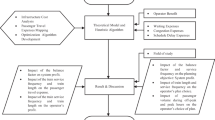Abstract
Due to the stochastic nature of traffic flow and passenger demand at stops, bus service is constantly subject to delays and disruptions. Therefore, dynamic vehicle scheduling is essential to reduce the negative effects of service disturbance. This paper proposes a novel hierarchical task network (HTN) planning approach for dynamic vehicle scheduling with stochastic trip times. In the approach, a hybrid dynamic control strategy is devised to achieve headway adherence. Experimental results demonstrate that the proposed approach can flexibly handle a variety of abnormal operating conditions and maintain a stable headway. Due to the consideration of stochastic trip times, the HTN-based dynamic vehicle scheduling can simulate real bus operations. It can not only flexibly simulate different scenarios, such as inserting new trips or vehicle breakdown, but also easily test different control strategies. This will assist dispatchers handling disruption agilely and enhance the service quality of public transport.











Similar content being viewed by others
Data availability
The datasets generated and analyzed during the current study are available from the corresponding author on reasonable request.
References
Liang S et al (2016) A self-adaptive method to equalize headways: numerical analysis and comparison. Transp Res Part B Methodol 87:33–43
Ibarra-Rojas OJ et al (2015) Planning, operation, and control of bus transport systems: a literature review. Transp Res Part B Methodol 77:38–75
Muñoz JC et al (2013) Comparison of dynamic control strategies for transit operations. Transp Res Part C Emerg Technol 28:101–113
Georgievski I, Aiello M (2015) HTN planning: overview, comparison, and beyond. Artif Intell 222:124–156
Berrebi SJ et al (2018) Comparing bus holding methods with and without real-time predictions. Transp Res Part C Emerg Technol 87:197–211
Daganzo CF (2009) A headway-based approach to eliminate bus bunching: systematic analysis and comparisons. Transp Res Part B Methodol 43(10):913–921
Xuan Y, Argote J, Daganzo CF (2011) Dynamic bus holding strategies for schedule reliability: OPTIMAL linear control and performance analysis. Transp Res Part B Methodol 45(10):1831–1845
Eberlein XJ, Wilson NHM, Bernstein D (2001) The holding problem with real-time information available. Transp Sci 35(1):1–18
Zolfaghari S, Azizi N, Jaber MY (2004) A model for holding strategy in public transit systems with real-time information. Int J Transp Manag 2(2):99–110
Delgado F, Munoz JC, Giesen R (2012) How much can holding and/or limiting boarding improve transit performance? Transp Res Part B Methodol 46(9):1202–1217
Wang X, Qing-dao-er-ji R (2018) Application of optimized genetic algorithm based on big data in bus dynamic scheduling. Clust Comput 22(S6):15439–15446
Kumar BA, Prasath GH, Vanajakshi L (2019) dynamic bus scheduling based on real-time demand and travel time. Int J Civil Eng 17(9A):1481–1489
Liu Y et al (2021) Dynamic bus scheduling of multiple routes based on joint optimization of departure time and speed. Discret Dyn Nat Soc 2021:1–20
Zhang Z et al (2006) An HTN-based mission planning model and algorithm for autonomous spacecraft. InL Isscaa 2006: 1st international symposium on systems and control in aerospace and astronautics, vols 1and 2, p 261
Belker T et al (2003) Learning to optimize mobile robot based on HTN plans a navigation. In: 2003 IEEE international conference on robotics and automation, vols 1–3, Proceedings. p 4136–4141
Li M et al (2016) Handling temporal constraints with preferences in HTN planning for emergency decision-making. J Intell Fuzzy Syst 30(4):1881–1891
Shen Y, Xu J, Li J (2016) A probabilistic model for vehicle scheduling based on stochastic trip times. Transp Res Part B-Methodol 85:19–31
Chen J et al (2015) Design of limited-stop bus service with capacity constraint and stochastic travel time. Transp Res E-Log 83:1–15
Mazloumi E, Currie G, Rose G (2010) Using gps data to gain insight into public transport travel time variability. J Transp Eng 136(7):623–631
Shen Y, Zhang T, Xu J (2014) homogeneous bus running time bands analysis based on K-means algorithms. J Transp Syst Eng Inf Technol 14(2):87–93
Nau D et al (2003) SHOP2: an HTN planning system. J Artif Intell Res 20:379–404
Furth PG, Hemily B, Muller THJ, Strathman JG (2006) Using archived AVL-APC data to improve transit performance and management. TCRP Report
Ceder A (2007) Public transit planning and operation: theory, modelling, and practice. Elsevier
Acknowledgements
This research is supported by the National Natural Science Foundation of China under Grants No. 71571076 and No. 72071087, and sponsored by CAAI-Huawei MindSpore Open Fund (CAAIXSJLJJ-2022-034A).
Author information
Authors and Affiliations
Corresponding author
Ethics declarations
Conflict of interest
The authors have no conflicts of interest to declare that are relevant to the content of this article.
Additional information
Publisher's Note
Springer Nature remains neutral with regard to jurisdictional claims in published maps and institutional affiliations.
Rights and permissions
Springer Nature or its licensor (e.g. a society or other partner) holds exclusive rights to this article under a publishing agreement with the author(s) or other rightsholder(s); author self-archiving of the accepted manuscript version of this article is solely governed by the terms of such publishing agreement and applicable law.
About this article
Cite this article
Shen, Y., Yan, M. HTN planning for dynamic vehicle scheduling with stochastic trip times. Neural Comput & Applic 35, 9917–9930 (2023). https://doi.org/10.1007/s00521-023-08228-2
Received:
Accepted:
Published:
Issue Date:
DOI: https://doi.org/10.1007/s00521-023-08228-2




